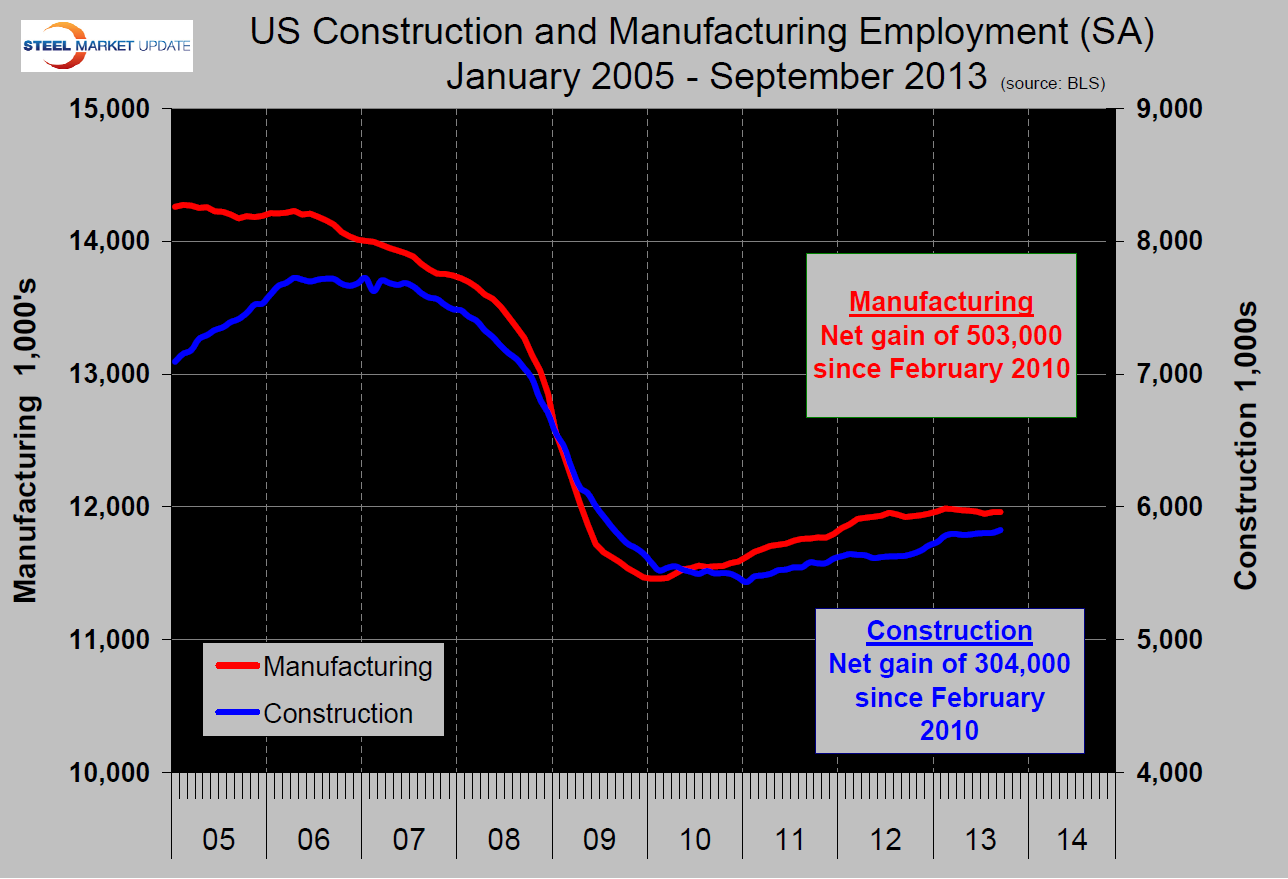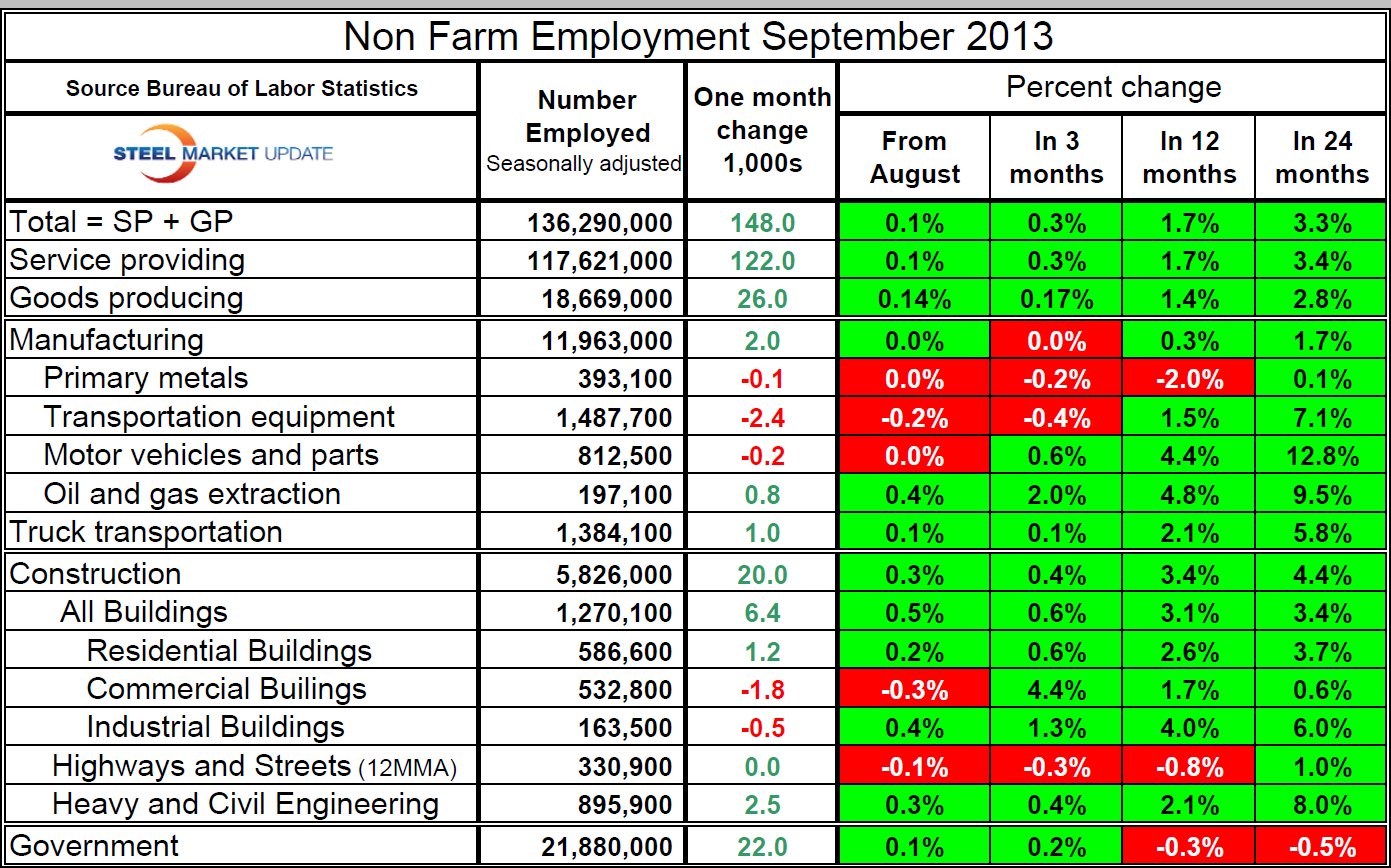Market Data

October 24, 2013
Non Farm Job Creation Disappoints in September
Written by Peter Wright
Net job creation in September was 148,000 of which 122,000 was service providing and 22,000 goods producing. Of the service providing 22,000 was in government. Of the goods producing, 2,000 were in manufacturing and 20,000 in construction (Table 1). Expectations had been for a gain of 180,000. Digging into the September numbers reveals weak growth in private services, particularly healthcare which added only 14,000 jobs compared to its six-month average of 25,000. Leisure and hospitality declined 13,000, compared with a six-month average gain of 36,000. Since February 2010 which was the employment low point following the recession manufacturing has added 503,000 jobs and construction 304,000 (Figure 1). Primary metals had a string of 32 monthly gains after November 2009 but since August 2012 has lost 14,000 jobs.
 Main points from the Bureau of Economic press release were; Total non-farm payroll employment rose by 148,000 in September, and the unemployment rate was little changed at 7.2 percent. Employment increased in construction, wholesale trade, and transportation and warehousing. The unemployment rate, at 7.2 percent, changed little in September but has declined by 0.4 percentage point since June. The number of unemployed persons, at 11.3 million, was also little changed over the month; however, unemployment has decreased by 522,000 since June. Among the major worker groups, the unemployment rates for adult men (7.1 percent), adult women (6.2 percent), teenagers (21.4 percent), whites (6.3 percent), blacks (12.9 percent), and Hispanics (9.0 percent) showed little or no change in September. The jobless rate for Asians was 5.3 percent (not seasonally adjusted), little changed from a year earlier. In September, the number of long-term unemployed (those jobless for 27 weeks or more) was little changed at 4.1 million. These individuals accounted for 36.9 percent of the unemployed. The number of long-term unemployed has declined by 725,000 over the past year. Both the civilian labor force participation rate, at 63.2 percent, and the employment- population ratio at 58.6 percent, were unchanged in September. Over the year, the labor force participation rate has declined by 0.4 percentage point, while the employment- population ratio has changed little. The number of persons employed part time for economic reasons (sometimes referred to as involuntary part-time workers) was unchanged at 7.9 million in September. These individuals were working part time because their hours had been cut back or because they were unable to find a full-time job.
Main points from the Bureau of Economic press release were; Total non-farm payroll employment rose by 148,000 in September, and the unemployment rate was little changed at 7.2 percent. Employment increased in construction, wholesale trade, and transportation and warehousing. The unemployment rate, at 7.2 percent, changed little in September but has declined by 0.4 percentage point since June. The number of unemployed persons, at 11.3 million, was also little changed over the month; however, unemployment has decreased by 522,000 since June. Among the major worker groups, the unemployment rates for adult men (7.1 percent), adult women (6.2 percent), teenagers (21.4 percent), whites (6.3 percent), blacks (12.9 percent), and Hispanics (9.0 percent) showed little or no change in September. The jobless rate for Asians was 5.3 percent (not seasonally adjusted), little changed from a year earlier. In September, the number of long-term unemployed (those jobless for 27 weeks or more) was little changed at 4.1 million. These individuals accounted for 36.9 percent of the unemployed. The number of long-term unemployed has declined by 725,000 over the past year. Both the civilian labor force participation rate, at 63.2 percent, and the employment- population ratio at 58.6 percent, were unchanged in September. Over the year, the labor force participation rate has declined by 0.4 percentage point, while the employment- population ratio has changed little. The number of persons employed part time for economic reasons (sometimes referred to as involuntary part-time workers) was unchanged at 7.9 million in September. These individuals were working part time because their hours had been cut back or because they were unable to find a full-time job.
In September, average hourly earnings for all employees on private nonfarm payrolls rose by 3 cents to $24.09. Over the year, average hourly earnings have risen by 49 cents, or 2.1 percent. In September, average hourly earnings of private-sector production and nonsupervisory employees rose by 4 cents to $20.24.








